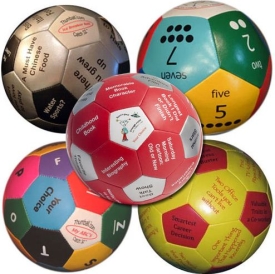Product Review: Thumball – from the SLP Perspective
By: Joleen Fernald, MS CCC-SLP, Doctoral Student

Editor’s Note: The following is the second of two product reviews on the Thumball! When I first saw a Thumball two years ago at ASHA, I thought that it looked like a very versatile tool for pediatric therapists of all types. Basically a smaller version of a soccer ball, each panel features a word or phrase, graphic, or photo. It can be used to stimulate conversation, improve social interactions, develop communication skills and much more.
We would like to thank Mary at Thumball for the product samples so we might bring you product reviews from both the Occupational Therapy and Speech-Language Pathology points of view. The following is a review by our friend Jolene Fernald, CCC-SLP.
Thumballs are described by their creators as “high quality, soft, stuffed, soccer-style balls” that can
- improve participation and group dynamics at workshops and team building events
- invigorate audiences periodically during classes and presentations
- address academic goals, IEPs, speech therapy, ESL, OT, PT and special needs
- enhance family fun night with a game all generations can play together
- customization available to HR managers, training organizations, schools, clubs, teams, niche markets and creative entrepreneurs.
Though there are many different types of Thumballs, I had the pleasure of using the “Who are you?” and “Category Mania” balls in multiple speech and language therapy sessions. The “Who are you?” ball includes a number of topics such as, “Favorite toy or game”, “Fun sport to play”, and “3 gross foods” that can be used during a social skills lesson or as a warm up to a therapy session. The “Category Mania” ball includes categories such as “Jungle animals”, “Things to read”, and “Occupations”. This ball was a great tool to work on rapid automatic naming and word retrieval during a game of Hot Potato.
Thumballs were most useful for children, both boys and girls, between the ages of 5 and 10 years old. Children who typically have tactile concerns were not sensitive to the feel or squishiness of the balls. The small size made it easier for younger children to catch. My only recommendation for improvement would be to offer a ball that utilizes pictures rather than words to allow non-readers to feel more independent during ball play, thus reducing the stress of having to decode and retrieve language.
Overall, Thumballs are a wonderful tool and can be easily added to therapeutic intervention for a range of disabilities.
Featured Product Reviewer: Joleen Fernald, CCC-SLP
Joleen Fernald, CCC-SLP is currently a PhD student studying infant mental health and developmental disabilities with the Interdisciplinary Council on Developmental and Learning Disorders founded by Dr. Stanley Greenspan. She has a special interest in the social emotional development of young children. As a speech-language pathologist, Joleen works with children with a variety of communication disorders. She has partnered with Easter Seals NH to begin an assessment and treatment clinic specifically for selective mutism, a social communication anxiety disorder and is the immediate past Chair of the Selective Mutism Group, a non-profit organization specializing in the advocacy of Selective Mutism awareness. Joleen enjoys public speaking and has presented nationally on the topics of childhood apraxia of speech and selective mutism. To learn more about Selective Mutism visit the SMG website at :www.selectivemutism.org. To learn more about Joleen and her work, please visit her website at: Joleen Fernald.com
PediaStaff is Hiring!
All JobsPediaStaff hires pediatric and school-based professionals nationwide for contract assignments of 2 to 12 months. We also help clinics, hospitals, schools, and home health agencies to find and hire these professionals directly. We work with Speech-Language Pathologists, Occupational and Physical Therapists, School Psychologists, and others in pediatric therapy and education.
